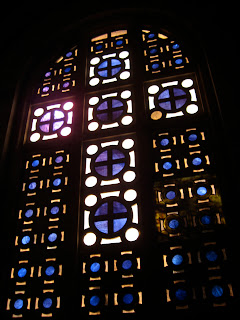Jerusalem
The Holy City
Of all of the days that we have been on this pilgrimage, today was by far the most busy (and the most emotional). It was our first day in Jerusalem and the focal point of our trip. We visited and had worship, told the Bible stories, prayed and sang in an unbelievable amount of amazing places.
Here is a SHORT list:
The Mount of Olives
(Palm Sunday, Christ's Ascension into Heaven)
The Palm Sunday Road
(From the Mount of Olives toward the Old City of Jerusalem) Mark 11:1-11
The Dominus Flevit
("The Lord Wept"--This refers to when Jesus wept over the city in Matthew 23:37-39)
The Garden of Gethsemane
(Where Jesus prayed to the Father to "let this cup pass" from him). Mark 14:32-42
The Church of All Nations
(Built in 1924 in the Garden of Gethsemane)
St. Stephen's Gate
(one of the many Gates that pass through the massive wall around the city).
This is where St. Stephen was stoned in the book of Acts.
Pool of Bethesda
(Where Jesus heals a paralytic in John 5:1-9)
St. Anne's Church
The only Crusader church left in the city.
Via Dolorosa
"The Way of Tears"
This is the traditional Stations of the Cross in Jerusalem. By walking the stations (while carrying a large wooden cross) we walked past:
The Praetorium
(Where Pilate Sentenced Jesus).
The narrow road
that Jesus walked with his cross through the city.
The Church of the Holy Sepulcher
(contains the tomb of Christ and Golgotha, where Christ was crucified)
The Chapel of the Divestiture
(Inside the Church of the Holy Sepulcher) where Jesus was stripped of his garments.
The Upper Room
Where Jesus had his last supper with his disciples. While we were there, Leona and I were asked to perform hand-washings instead of foot-washings for everyone in our group (John 13:1-17). This is also thought to be the site of Pentecost in The Book of Acts.
Caiaphas' Home
(containing the pit where many believed Christ was held overnight before his Crucifixion)
The Roman Steps
(Where Peter denied knowing Jesus three times and is also the path that Jesus would have taken from the upper room to Gethsemane)
The Western Wall.
The last surviving portion of the 2000 year old temple mount of Jesus time. We prayed at the wall with hundreds of others.
The view of the city that Christ would have had on Palm Sunday.
The City of David in the Old Testament.
The alter in The Dominus Flevit. Look closely, you can see the city of Jerusalem (and the Dome of the Rock) through the window behind the alter.
"Amazing Grace" in St. Anne's Church. This church has an 11 second echo!
One of the old olive trees in Gethsemane.
Marker for the 5th Station of the Cross on the Via Dolorosa.
The Gate directly above Rob's Head is called the "Golden Gate." This gate contains two large doors that always remain shut. It is believed that at the End of Days the Messiah will enter through these doors.
Some of the amazing (and intentionally dark) stained glass windows in The Church of All Nations.
Leona walking through the narrow streets of Jerusalem. Imagine carrying a cross through streets this narrow.
Our group singing Psalm 88 inside the pit in Caiaphas' home, where Jesus could have been imprisoned the night before he was crucified.
Rob drinking an Arabic Coke!
The Roman Steps that Christ would have walked to travel from the Upper Room to the Garden of Gethsemane.
Various people praying and blessing items on the rock where it was believed that Christ was taken down from the cross in The Church of the Holy Sepulcher.
A video of Christ's empty tomb in the Church of the Holy Sepulcher.
Leona outside the ornate doors of the Church of All Nations.
Rob had to wear a yarmulke to pray at the Western Wall.
The Western Wall.
Rob in Gethsemane.
Leona and Rob outside the Church of the Holy Sepulcher.
This has been an amazing and moving experience. I will never be able to read the scriptures the same way again. I look forward to sharing all that I have learned and seen here in the Holy Land with each of you.
-Rob







































.jpg)










.JPG)


